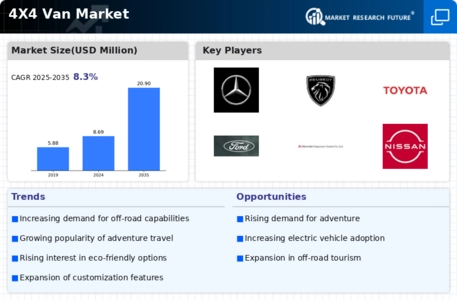Adoption Of Electric And Hybrid Powertrains In 4x4 Vans
One of the most significant trends shaping the automotive industry, including the 4x4 van sector, is the increasing adoption of electric and hybrid powertrains. With a global focus on reducing greenhouse gas emissions and transitioning towards sustainable energy solutions, 4x4 vans are aligning with this paradigm shift. Electric and hybrid powertrains offer a range of benefits, including lower emissions, reduced fuel costs, and quieter operation, making them an attractive option for environmentally conscious consumers and businesses alike.
Major automakers are making substantial investments in the development of electric and hybrid 4x4 van models, recognizing the growing demand for eco-friendly transportation solutions. These investments are driving innovation in battery technology, leading to improvements in range and charging capabilities, thus addressing key concerns related to electric vehicle adoption.
The integration of electric and hybrid powertrains in 4x4 vans represents a significant step towards sustainability and environmental stewardship in the transportation sector. By reducing reliance on fossil fuels and minimizing emissions, electric and hybrid 4x4 vans contribute to efforts aimed at mitigating climate change and promoting cleaner air quality in urban and rural environments. Moreover, the adoption of electric and hybrid powertrains in 4x4 vans reflects a broader industry-wide shift towards electrification, with manufacturers leveraging technological advancements to meet evolving consumer preferences and regulatory requirements.
As governments around the world implement stricter emission standards and incentivize the adoption of electric vehicles, the demand for electric and hybrid 4x4 vans is expected to grow steadily in the coming years.
Increasing Focus On Safety Features
Safety remains a paramount concern in the automotive industry, and the domain of vans is witnessing a notable emphasis on advanced safety features. Manufacturers are integrating cutting-edge technologies to enhance driver and passenger safety, mitigate accidents, and boost confidence on the road. Van manufacturers are incorporating an array of advanced safety features into their models, including collision avoidance systems, lane departure warnings, blind-spot monitoring, and adaptive cruise control. These features play a pivotal role in preventing accidents and minimizing the severity of collisions by providing real-time alerts and assistance to drivers.
Among the crucial safety features gaining prominence is Electronic Stability Control (ESC), a technology that leverages sensors to monitor the van's movement and applies brakes to specific wheels, ensuring stability during sudden maneuvers or loss of traction. ESC significantly reduces the risk of rollovers and enhances overall vehicle control, especially in emergency scenarios. Another vital safety feature is the Anti-lock Braking System (ABS), which prevents wheel lock-up during heavy braking, enabling the driver to maintain steering control and prevent skidding. ABS enhances vehicle stability and reduces braking distances, particularly on slippery surfaces.
Airbags, strategically placed throughout the van's cabin, provide crucial protection to occupants in the event of a collision, minimizing the risk of serious injuries. Meanwhile, Blind Spot Monitoring, Lane Departure Warning, and Tire Pressure Monitoring System (TPMS) offer additional layers of safety by alerting drivers to potential hazards and ensuring optimal tire performance. Rearview cameras have become standard in modern vans, offering clear visibility of the area behind the vehicle during reversing maneuvers, thereby minimizing blind spots and enhancing overall safety.
Adaptive Cruise Control further enhances safety by automatically adjusting the van's speed to maintain a safe distance from the vehicle ahead, reducing the risk of rear-end collisions and driver fatigue.
The integration of these advanced safety features underscores the industry's commitment to prioritizing passenger well-being and reducing accidents on the road. With ongoing advancements in technology, future passenger van models are poised to feature even more innovative safety solutions, ensuring a safe and comfortable journey for all occupants.
The increasing demand for versatile and rugged vehicles in urban and off-road environments suggests a robust growth trajectory for the global 4X4 van market.
U.S. Department of Transportation



















Leave a Comment